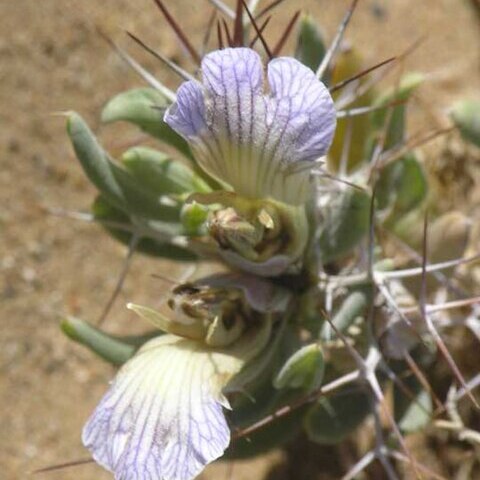Dense compact prostrate cushion-shaped shrubby herb or shrub to 20 cm tall and 40 cm in circumference usually with internodes less than 2 cm long, more rarely a dense subglobose shrub to 0.6(-1) m tall and 0.8 m in circumference (rarely flowering as an annual herb); young branches yellowish to dark brown, glabrous to scabrid-puberulous, in Namibia sometimes with scattered longer hairs to 1 mm. Leaves often greyish, subglabrous to minutely scabrid-puberulous, in Namibia often with scattered longer (to 2 mm) hairs on midrib and above, white-dotted when old; lamina ovate to elliptic or obovate or narrowly so, largest 1.5-6.5(-8) x 0.3-1.5 cm; in Namibia margin on all with 5-25 teeth, in South Africa with 1-9(-12) teeth or some entire; in Namibia petiole on some or all within 1 mm of stem with (more rarely without) a single (rarely two) tooth to 6 mm long on each side, in South Africa without teeth; lateral veins sometimes white above. Spikes never proliferating, 1.5-6 cm long, 2-16-flowered, subsessile or peduncle to 15(-25) mm long with 3-6 pairs of gradually larger sterile bracts all with lamina; fertile bracts greenish to whitish, becoming brownish, subglabrous to puberulous or sericeous-puberulous and often with scattered long (to 2 mm) spreading hairs on veins, often long-ciliate apically, lower and middle obovate or broadly so, 17-43 x (6-)7-14(-18) mm of which the straight to recurved spinose tip 6-23 mm, tip narrowly triangular, not (sides converging) or slightly (sides parallel) constricted below apical pair of teeth, on each side with (2-)3-4(-7) teeth of which the longest 5-14 mm. Bracteoles linear-lanceolate, 10-20 x 1-3 mm, narrowing gradually or abruptly above base, not pungent. Sepals minutely puberulous or sericeous-puberulous to puberulous (rarely sparsely so), often with scattered (rarely dense) long (to 2(-3) mm) hairs on veins and long-ciliate; dorsal 14-21 mm long, 5-7-veined from base, ovate-elliptic, ligulate and narrowing gradually to the acute mucronate 1-3-toothed tip, apical part somedmes scarious and disintegrating thus appearing truncate and irregularly toothed; ventral 8-13 mm long, 5-7-veined from base, broadly ovate-elliptic, narrowing gradually to a truncate apex without or with 2(-3) teeth 0.5-1.5(-2) mm long; lateral ovate or broadly so, 5-8 mm long. Corolla white to pale blue or bright blue or mauve to violet with darker veins, 20-29 mm long of which the tube 4-6 mm; limb obovate-spathulate, 8-15 mm wide, central lobe longer than wide to wider than long, truncate to retuse (rarely rounded), irregularly toothed, not or slightly constricted at base; filaments 7-9 mm long, glabrous or sparsely glandular towards apex, two broad or all four hairy towards base; appendage 2-5 mm long, oblong, narrowing slightly to the rounded often twisted tip, shorter to longer than anther; anthers 2.5-5 mm long. Capsule 7-11 mm long; seed 4.5-6 x 3.5-4.5 mm.
More
Perennial, dwarf shrub, 0.1-0.2 m high, usually with internodes < 20 mm long and often with spikes hidden in erect leaves. Bracts: fertile ones obovate or broadly so, with 2 or 4(-7) pairs of lateral spines; lower and middle fertile bracts 22-35 mm long, with spinose apex (6-)8-18 mm long. Sepal: ventral one 8-13 mm long, with or without apical teeth up to 1.5(-2.0) mm long. Corolla 23-37 mm long, limb 12-18 mm wide. Flowering time all year.
Dense, spiny, prostrate, cushion-shaped shrubby herb, up to 200 mm tall. Leaves subpetiolate, ovate to obovate, often greyish, margin bristle-toothed or occasionally entire. Flowers 2-16, in subsessile or pedunculate spikes white to pale or bright blue or mauve to violet with darker veins; bracts greenish to whitish, becoming brownish, often with long scattered hairs on veins. Capsules 7-11 mm long.
Perennial herb; with prominent internodes. Stems procumbent. Leaves sessile; blade ovate to narrowly obovate, flat, ± 50 x 10 mm, decurrent, margins with a few irregular, short, spiny teeth. Flowers: in elongate, pubescent spikes; bracts obovate, white hairy; corolla white or blue; May-Jan.

